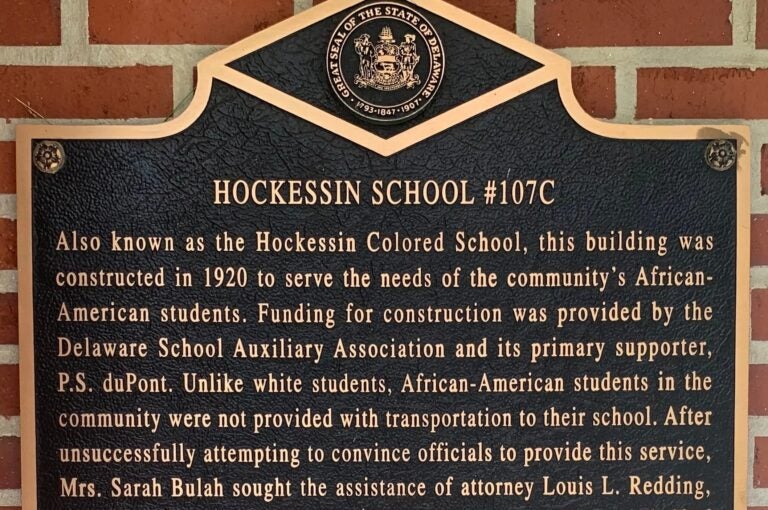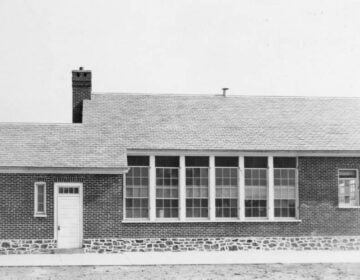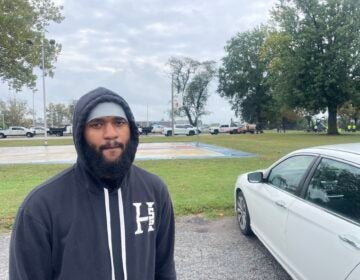Delaware schools that helped end segregation are now part of a national historic park
Three Delaware schools that played a key role in the fight against segregation have been added to the Brown v. Board of Education National Historical Park.
Listen 1:36
File - A plaque on the front of Hockessin School #107C. (Sarah Mueller/WHYY)
From Philly and the Pa. suburbs to South Jersey and Delaware, what would you like WHYY News to cover? Let us know!
A trio of northern Delaware schools will join school buildings in Kansas, South Carolina, Virginia and Washington, D.C., as part of Brown v. Board of Education National Historical Park. The inclusion of the Delaware schools comes after a 2022 law allowed the park, which initially was only housed in a Topeka school, to include affiliate sites.
The expansion to Delaware includes new recognition for Hockessin School #107, Claymont High School and Howard High School in Wilmington.
Claymont High is now home to the Claymont Community Center; Howard High is still in use as a vocational-technical high school; and the Hockessin school has been transformed into the Center for Diversity, Inclusion, and Social Equity.
James Knott remembers the feeling of walking through the doors of Hockessin School #107 as a child — its wooden floors, the smell of chalk dust, the quiet whispers of his classmates. It was a one-room school with six grades and a single teacher. He recalls their limited resources.
“Sometimes we will be reading a book and turn to the next page and wouldn’t be there because, you see, we never got new books. We got the old book from the white school up on the hill and they got the new books,” he said. “Everything we had was secondary. At that time the walls were pretty much covered with big blackboards, and we did a lot of work on the blackboards. Sometimes we were given a half a piece of chalk or a half a pencil. We had to make due.”
Those experiences shaped history and shifted the trajectory of education.
The Delaware case that was part of the Brown v. Board ruling — one of five — was called Belton v. Gebhart. One of the plaintiffs in that case was forced to attend the all-Black Hockessin school without being provided the same public transportation offered to white students. Claymont High denied Black students admission, forcing them to travel further to the first Black high school in Delaware, Howard High.
Knott, now 94, calls his time at the Hockessin school as a significant chapter in his life — one cemented in the nation’s legacy. Yet, he had doubts about whether the school’s recognition would ever come.
“When they were first talking about refurbishing the school and making it presentable, we said, ‘Oh yeah, we’ve heard that song before, which we had, but it never happened,’” he admitted. “But now we can take our children and grandchildren there and show them exactly what it was like.”
David Wilk, interim CEO of Hockessin Colored School #107, emphasized the significance of the site’s inclusion in the national park system, a recognition long overdue.
“[The] gift of our whole mission was that there were 12 to 15 students who went to the school,” he said. “To be able to turn around and take their school, which is in a state of disrepair and turn it into a center for diversity, inclusion and social equity, which it is today, and for them to be able to walk through the doors again in their lifetime and see their school come back to life.”
With its new status from the National Park Service, the school will “continue to do innovative programming around social infrastructure and being in what we call inclusive prosperity, trying to be able to help future generations to live prosperous and flourishing lives,” Wilk said. “That [is] really at the heart of our mission. Not to just be a museum … but to be a place of programming, innovation and value creation.”
For Allison David, CEO of Claymont Community Center, it’s not only about giving back to those students, but also about preserving and sharing the history of all three locations.
“This designation allows for the full telling of the story, and we understand the importance of sharing Claymont’s role. Knowing our past inspires us to work towards a more equitable society now, and this legacy of inclusion is central to our work in the community,” she said.
In 1952, Delaware courts ruled in favor of the plaintiffs in the Belton v. Gebhart case and against the state’s segregated system. Of the combined five cases that made up Brown v. Board of Education, Belton v. Gebhart was the only case in which the lower courts found discrimination to be unlawful.
“One of the important things to note is that Delaware got this right two years before Brown v. Board of Education. This was one of the cornerstone cases put into the Brown legislation. So, that’s why it’s pretty significant. This was a case of showing that integration worked, that it had been done two years before the Brown v. Board case,” David added.
At Hockessin School #107 and Claymont Community Center, there are discussions about developing new community programs focused on social justice, mentorship and workforce development to continue the legacy of advocacy that the school represents.
James Knott hoped the new recognition for his old school draws more people to learn of what he and many other students experienced.
“Come and see where we came from,” he said. “If you don’t know where you’ve been, then you don’t know where you’re going. This is our history, and it’s important that it is not forgotten.”

Get daily updates from WHYY News!
WHYY is your source for fact-based, in-depth journalism and information. As a nonprofit organization, we rely on financial support from readers like you. Please give today.






